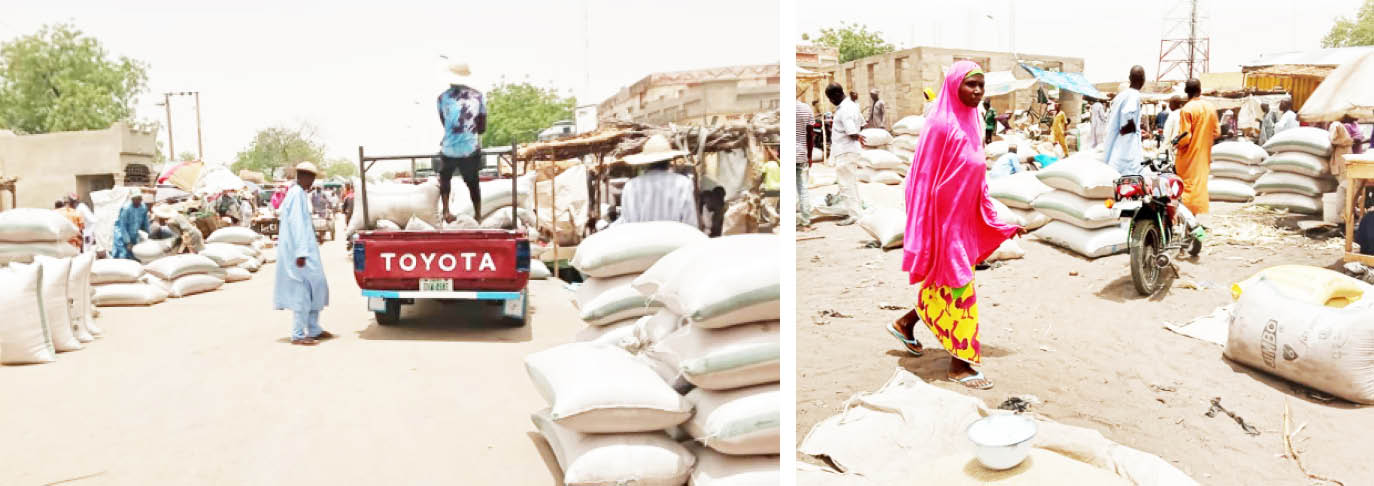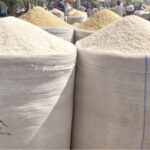The over 200-kilometre Kano-Hadejia highway is the route to arguably the largest hub of rice and wheat farming in not only Nigeria but West Africa. The stretch, which is dotted by several towns from Gezawa in Kano State to Hadejia in Jigawa, has a vast array of arable land for both wet and dry season farming.
Between these two towns are several towns and local government areas, including Garki, Sule Tankarkar, Gumel and Malam Madori, while Auyo is just a few kilometres off the road from Hadejia.
Put together, these local governments have the economic potential of revolutionising the Nigerian government’s push to diversify its economy from overdependence on oil and gas, farmers, businessmen and experts have said. For instance, from Garki to Sule Tankarkar to Gumel and Malam Madori, food crops like sesame, millet, sorghum, beans, groundnut, guinea corn and hibiscus are cultivated at such a high volume that rivals any other area in the country.
Ibrahim Dodo, one of the large-scale farmers in Gumel, believes that the major challenge for them is seeking out markets for their products, insinuating that the area generates so much farm produce that getting the market for selling them is what is limiting them.
He said if there were more investments in the axis by the government and private sectors, the farmers would take advantage of the hitherto uncultivated arable lands in the axis and produce more.
Aside from the crop, Maigatari, the Nigerian border town to the Niger Republic, which is about 18 kilometres from Gumel, is renowned for its international livestock market. The market, during its peak period, records transaction of over N1billion every market day (Thursdays). According to the Sarkin Pawa of Gumel, Alhaji Sale Alhassan, Gumel and other towns along the Kano-Hadejia highway benefit immensely from the market because the road (via Gumel) is the only one connecting the market to the rest of Nigeria.
For several years, the Hadejia rice market has been known as one of the popular markets where the business of paddy rice is booming. Despite a relatively small land size, the market takes delivery of over 2,000 tonnes of paddy rice on every market day (Sundays).
Aside from Hadejia itself, the supply of the commodity to the market largely comes from about eight surrounding local government areas, majorly Auyo, which is just about 30 kilometres away.
“Auyo is the rice hub in the whole of northern Nigeria, the country, as well as West Africa. Like the groundnut pyramid of those days, you can get rice pyramid from Auyo. In this Hadejia-Auyo axis, we have about eight integrated rice mills. Just a bit off the road to Auyo, there is a mega rice mill project of Dangote currently ongoing. And you know that anywhere you see Dangote putting his investment, there is an opportunity there,” said Muhammad Auwal, an owner of a rice mill in Hadejia.
His views were corroborated by a major rice farmer in Auyo, Alhaji Garba Suleiman Auyo, who is also the chairman of Apex Waterways Association under the Hadejia-Jama’are irrigation project.
Communities in this axis are taking the lead in the production of paddy rice because they fall within the areas that the Hadejia-Jama’are River passes through.
As a result of the boom in rice farming, championed by the federal government, the huge supply of the commodity to the market has grown from attracting a large number of individual buyers to also adding value to the activities of other major players in the paddy rice business. For instance, rice processing companies have taken over the market as they buy paddy rice in volumes for onward processing.
Auwal, a former civil servant who voluntarily resigned to go into business, explained that aside from the integrated rice mills, there are a lot of cottage mills, as well as small and medium scale rice mills all over the area.
“So, when you take the value chain of production from cultivation to processing, up to retailing, there are a lot of people engaged and involved,” he added.
He said he invested over N40million to set up his rice mill in November 2021 and is very optimistic that in a very short time, he is going to recoup his investment, judging by the progress already recorded.
One of the small scale rice farmers in Hadejia, Kabiru Kaja, who was met on his farm while planting, explained that he got an average yield of over 200 bags of rice paddy from his relatively small farmland during every farming season.
He said he just harvested about 55 bags from a small portion of his farm, and each bag was sold at N21,000, meaning that he has raked in over N1million even before the usual harvest period.
Conducting our correspondent round his farm, Kaja pointed at a neighbouring farmland owned by a politician, and according to him, from his conversation with workers on the farm, his neighbour harvests 1,000 bags of paddy every season, on the average. He added that there are farmers who harvest as much as 2,000 bags.
One of the rice millers in the axis said that during the last harvest period when the product was surplus, they bought a bag at N14,500. This means that even the small scale farmers who averagely harvest between 50 and 60 bags normally smile to the bank.
“Multiply 50 bags by N14,500 and you are talking of N725,000. Presently, I buy it at N21,000 and N22,000 per bag, but at harvest when it is surplus, it averagely goes for N14,500,” he said.
Wheat is another farm produce that is cultivated in large quantity in the Hadejia axis.
Auwal recalled that when the late premier of the Northern Region, Ahmadu Bello, brought back wheat seedlings from Sudan, it was tested in two locations: Sokoto and Hadejia, and “Hadejia is the best in yield. Right now, our yield per hectare surpasses every yield you can come across, not only in Nigeria but the whole of West Africa. This was ascertained by Sasakawa Global 2000. You can get as much as 9 to 10 tonnes per hectare.”
And like wheat, sesame yield along the Kano-Hadejia highway axis is also top on the list, just as the area is also doing immensely in hibiscus cultivation.
“So this axis is an opportunity hub, it is a place where you can get a lot of return on your investment.
“Now, Irish potato, which was normally grown in Plateau and Nasarawa areas, was brought to Hadejia, and in terms of yield, it was found that ours is much bigger than that of Plateau and Nasarawa. Anything agriculture that has to do with land tilling, when you plant it in Jigawa, particularly the Hadejia axis, you will get more yield because our land is very hard clay that retains a lot of water. Our water topology is very good,” Auwal said.
In one of the ongoing federal government projects under the Hadejia-Jamare River Basin Development Agency in the axis, there are about 12,000 acres of farmland connected to the irrigation facility.
Fishing is another business area that Hadejia is known for across the country because of the river surrounding the area.
Fish farmers in the area estimated that on a weekly basis they make business transactions worth over N200million.
Despite the huge gains already being recorded, Auwal, the rice mill owner, believes there is even more room for investors.
“From the value chain, those who sell agrochemicals make money; those who provide services like tractor hiring, threshing machines, willowers and those who operate warehousing facilities will make money here. Our weekly market is on Sundays. During rice season, 50 to 70 trucks of rice paddy leave Hadejia every day,” he said.
Alhaji Garba Suleiman Auyo, the chairman of Apex Waterways Association, under the Hadejia-Jama’are irrigation project, also buttressed the call for more investors in the area.
“The best help we can get is to have the right machines that will ease what we are doing because the volume of what we are producing is much and we are mostly doing it manually,” he said.
From Garki to Maigatari to Hadejia, farmers and traders in this axis believe that as much as their area is a haven of business opportunity, several investments need to be made to get full value for these opportunities. These investments, they believe, do not have to be only along the agricultural chain but also in technological areas like telecommunication networks.
“One of the challenges I have is reaching traders right from my farm because of the reach of network. I have also heard many traders complain of not being able to reach us at the time they need us,” a farmer in Hadejia said.
In the Maigatari International Livestock Market, as with other markets in the area, traders said they depended on network providers to be able to carry out their transactions because the era of moving around with cash was long gone; as such, they need good network to successfully conduct their businesses.

 Join Daily Trust WhatsApp Community For Quick Access To News and Happenings Around You.
Join Daily Trust WhatsApp Community For Quick Access To News and Happenings Around You.



